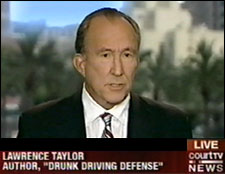How Do Police Spot Drunk Drivers?
Monday, October 24th, 2016Most of the time, officers don’t know that a person is actually drunk when they pull that person over. You can bet, however, that they’re suspicious. It’s not just the commission of a traffic violation itself that gives them suspicion. It could very well be a number of things.
So what do officers look for when spotting a suspected drunk driver?
Because people who are under the influence have trouble with vision and balance, they often have trouble driving in a straight line. This means that they may weave through traffic, cannot stay in their own lane, drift, straddle one side of a lane, swerve, and/or make wide turns. The California Court of Appeals has held that “pronounced weaving within a lane provides an officer with reasonable cause to stop a vehicle on suspicion of driving under the influence where such weaving continues for a substantial distance.”
Drivers who are under the influence also often have trouble gauging speed and distances. As a result, many drunk drivers have trouble stopping their vehicles as a sober person would. This includes stopping their vehicle too far from a curb or a stop sign as well as stopping their vehicle too suddenly.
Similarly, drunk drivers may also have trouble accelerating and often accelerate abruptly rather than gradually. They might also have trouble maintaining a consistent speed. Now it would be unreasonable to expect a person to maintain the speed perfectly, however the speed of drunk drivers often fluctuates more drastically than one might reasonably expect of a sober driver.
What I’ve mentioned are what officers look for, but what about what they listen for? I’m not talking about the sound of drunk drivers. I’m talking about anonymous tips from callers who may suspect that a person is driving under the influence. Can an officer use an anonymous tip to help him or her “spot” a drunk driver?
In the recent case of Navarette v. California, the United States Supreme Court held that an anonymous tip can give law enforcement the authority to pull someone over on suspicion of driving under the influence. This is true even though it is impossible to verify the reliability of the tip and the officer has not witnessed any driving that would indicate intoxication.
Like I said at the beginning of this post, these are the things that give officers the authority to pull someone over with only the suspicion that they may be driving under the influence. These things alone, however, are not enough to give the office the probable cause to arrest the person on suspicion of driving under the influence.
Once pulled over for the reasons mentioned above, the officer can substantiate their suspicion that the driver is under the influence with their own observations in making the stop. These are the pieces of information that have become as common in DUI police reports as the officer’s name, namely the smell of alcohol, the slurring of words, and the bloodshot and watery eyes of the driver. The officer can then further substantiate their suspicion and produce the probable cause needed to make the DUI arrest if the driver agrees to and fails field sobriety tests and/or produces a pre-arrest breathalyzer result above a 0.08 blood alcohol content.
Whether you’ve had a drink or not, be mindful of what the prying eyes of law enforcement officers are looking for in spotting drunk drivers.


